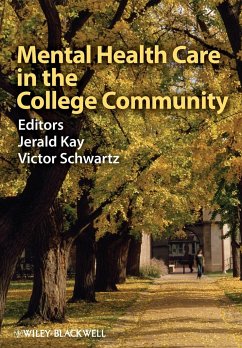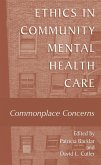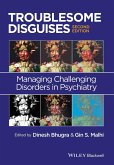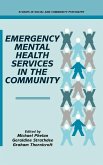Mental Health Care in the College Community
Herausgeber: Kay, Jerald; Schwartz, Victor
Mental Health Care in the College Community
Herausgeber: Kay, Jerald; Schwartz, Victor
- Broschiertes Buch
- Merkliste
- Auf die Merkliste
- Bewerten Bewerten
- Teilen
- Produkt teilen
- Produkterinnerung
- Produkterinnerung
Mental health concerns are the most serious and prevalent health problems among students in higher education. Increasingly effective psychopharmacological and psychotherapeutic treatments have facilitated matriculation for students with histories of anxiety, mood, personality, eating and substance abuse disorders. This phenomenon has been accompanied by a striking increase in the number of previously undiagnosed students requesting treatment. College and university mental health programs struggle to care for larger numbers of students, necessitating greater interdisciplinary collaboration in…mehr
Andere Kunden interessierten sich auch für
![Ethics in Community Mental Health Care Ethics in Community Mental Health Care]() Patricia Backlar / David L. Cutler (eds.)Ethics in Community Mental Health Care191,99 €
Patricia Backlar / David L. Cutler (eds.)Ethics in Community Mental Health Care191,99 €![Troublesome Disguises Troublesome Disguises]() Dinesh BhugraTroublesome Disguises121,99 €
Dinesh BhugraTroublesome Disguises121,99 €![Traumatic Relationships and Serious Mental Disorders Traumatic Relationships and Serious Mental Disorders]() Jon G AllenTraumatic Relationships and Serious Mental Disorders157,99 €
Jon G AllenTraumatic Relationships and Serious Mental Disorders157,99 €![Outcome and Innovation in Psychological Treatment of Schizophrenia Outcome and Innovation in Psychological Treatment of Schizophrenia]() Outcome and Innovation in Psychological Treatment of Schizophrenia113,99 €
Outcome and Innovation in Psychological Treatment of Schizophrenia113,99 €![The Psychiatric Mental Status Examination The Psychiatric Mental Status Examination]() Paula T TrzepaczThe Psychiatric Mental Status Examination112,99 €
Paula T TrzepaczThe Psychiatric Mental Status Examination112,99 €![Emergency Mental Health Services in the Community Emergency Mental Health Services in the Community]() Michael Phelan / Geraldine Strathdee / Graham Thornicroft (eds.)Emergency Mental Health Services in the Community237,99 €
Michael Phelan / Geraldine Strathdee / Graham Thornicroft (eds.)Emergency Mental Health Services in the Community237,99 €![Psychodynamic Formulation Psychodynamic Formulation]() Deborah L CabanissPsychodynamic Formulation70,99 €
Deborah L CabanissPsychodynamic Formulation70,99 €-
-
-
Mental health concerns are the most serious and prevalent health problems among students in higher education. Increasingly effective psychopharmacological and psychotherapeutic treatments have facilitated matriculation for students with histories of anxiety, mood, personality, eating and substance abuse disorders. This phenomenon has been accompanied by a striking increase in the number of previously undiagnosed students requesting treatment. College and university mental health programs struggle to care for larger numbers of students, necessitating greater interdisciplinary collaboration in treatment, research, outreach, and educational services. This book fills an important gap in the literature and provides a comprehensive resource for nearly every aspect of college mental health. It includes a strong emphasis on the training and education of graduate and professional students for future work in this field. Chapters are devoted to the significant ethical and legal issues related to treatment and associated administrative and policy challenges. Scholarly chapters on the promise of community mental health and public health approaches are especially innovative. There is also a chapter on international issues in college mental health which will be helpful to those students studying abroad. Mental Health Care in the College Community is written by acknowledged experts from mental health, college and university administration, legal and educational disciplines, all with extensive administrative and clinical experience in higher education settings. This book is clearly written and well illustrated with abundant tables, charts, and figures. This text will become essential reading for college mental health clinicians, graduate students in the mental health disciplines (psychiatry, psychology, counselling, nursing, and social work), student affairs deans and their staff, and even presidents or provosts of universities and colleges.
Hinweis: Dieser Artikel kann nur an eine deutsche Lieferadresse ausgeliefert werden.
Hinweis: Dieser Artikel kann nur an eine deutsche Lieferadresse ausgeliefert werden.
Produktdetails
- Produktdetails
- Verlag: Wiley
- Seitenzahl: 400
- Erscheinungstermin: 26. April 2010
- Englisch
- Abmessung: 244mm x 170mm x 22mm
- Gewicht: 681g
- ISBN-13: 9780470746189
- ISBN-10: 0470746181
- Artikelnr.: 29928469
- Herstellerkennzeichnung
- Libri GmbH
- Europaallee 1
- 36244 Bad Hersfeld
- gpsr@libri.de
- Verlag: Wiley
- Seitenzahl: 400
- Erscheinungstermin: 26. April 2010
- Englisch
- Abmessung: 244mm x 170mm x 22mm
- Gewicht: 681g
- ISBN-13: 9780470746189
- ISBN-10: 0470746181
- Artikelnr.: 29928469
- Herstellerkennzeichnung
- Libri GmbH
- Europaallee 1
- 36244 Bad Hersfeld
- gpsr@libri.de
Dr. Kay is a Fellow of the American College of Psychiatrists and Distinguished Life Fellow of the American Psychiatric Association and has served as the chair of the APA Committee on Medical Student Education, the Council on Medical Education and Career Development, the Vestermark Award Board, and the Committee on the Practice of Psychotherapy. He chairs the World Psychiatric Association Task Force on Undergraduate and Post Graduate Curriculum as well as the APA Committee on College Mental Health. Dr. Kay is the immediate past chair of the Psychiatry Residency Review Committee of the ACGME and the Founding Editor of the Journal of Psychotherapy Practice and Research and Associate Editor of the American Journal of Psychotherapy . He has published extensively on the topics of medical and psychiatric education, medical ethics, child psychiatry, psychoanalysis, psychotherapy, the neurobiology of psychotherapy, and psychosocial aspects of AIDS and of cardiac transplantation, and has edited numerous books. Dr. Kay serves as the Associate Director of the Comprehensive Neuroscience Center at Wright State University. He received the 2001 APA Seymour Vestermark Award for contributions to psychiatric education. Dr. Kay's current research examines fMRI in borderline personality disordered patients with self-harm behavior. Dr. Victor Schwartz is currently university dean of students at Yeshiva University and associate professor of clinical psychiatry at Yeshiva's Albert Einstein College of Medicine. He established and was director of the Counseling Center at Yeshiva. Previously Dr. Schwartz was for many years the medical director and chief psychiatrist at the University Counseling Service at New York University. He has also served as assistant director of residency training in psychiatry at NYU School of Medicine. He is a Distinguished Fellow, an original member of the Presidential Task Force on College Mental Health and a member of the Committee on College Mental Health, and co-chair of the working group on law and college mental health all of the American Psychiatric Association. He is also a co-chair of the Committee on the College Student of the Group for the Advancement of Psychiatry. He has written and lectured extensively on college mental health; particularly around the areas of the intersection of law, administration and college mental health, the management of mental health crises in colleges, psychiatric residency training in college mental health services and psychopharmacology practice in college mental health.
Preface.
List of Contributors.
1 The Rising Prominence of College and University Mental Health Issues (
Jerald Kay).
1.1 Introduction.
1.2 How prevalent are emotional disturbances and mental disorders?
1.3 Study limitations.
1.4 A developmental approach to college mental health.
1.5 Ethical and legal issues.
1.6 Conclusion.
2 History of College Counseling and Mental Health Services and Role of the
Community Mental Health Model (Paul Barreira and Malorie Snider).
2.1 Introduction.
2.2 Early development of college and university counseling centers and
mental hygiene programs: pre-1945.
2.3 Professionalism and response to increase in student enrolment.
2.4 Formalization of roles and attention to developmental issues and
prevention.
2.5 Community Mental Health Movement.
2.6 An example of the early application of community mental health at
colleges and universities: Dana Farnsworth.
2.7 Potential modern applications of the CHMmodel to educational settings.
2.8 Conclusion.
References.
3 The Reporting Structure and Relationship of Mental Health Services with
Health Services (Gregory T. Eells and Victor Schwartz).
3.1 Introduction.
3.2 Review of literature.
3.3 Administrative integration issues.
3.4 Clinical issues.
3.5 Recommendations.
3.6 Conclusion.
4 Components of an Effective College Mental Health Service (Gregory T.
Eells and Robert A. Rando).
4.1 Introduction.
4.2 Leadership philosophy and staff morale.
4.3 Administrative issues.
4.4 Clinical services.
4.5 Working with outside community mental health resources.
4.6 Conclusion.
Appendix A: Triage form (Adapted from Cornell University).
5 Essential Services in College Counseling (Richard J. Eichler and Victor
Schwartz).
5.1 Introduction.
5.2 Access to care.
5.3 Clinical consultation, treatment planning and referral.
5.4 Personal counseling and brief psychotherapy.
5.5 Medication services.
5.6 Referring students for consultation.
5.7 Group therapy in college mental health services.
5.7.1 Types of groups.
5.8 Psychological testing and assessment.
5.9 Community outreach.
5.10 Concluding remarks.
Appendix A: The relationship between predictive validity and base rate.
6 The Counseling Center Team (Paul Grayson).
6.1 Introduction.
6.2 The team.
6.3 Challenges to morale and teamwork.
6.4 The director's responses.
7 Legal and Ethical Issues in College Mental Health (Karen Bower and Victor
Schwartz).
7.1 Introduction.
7.2 Conceptual framework.
7.3 Legal framework.
7.4 Application.
7.5 Conclusion.
8 Working with the Campus Community (Lorraine D. Siggins).
8.1 Introduction.
8.2 Some developmental considerations.
8.3 The evolution of the college mental health service mission.
8.4 The college mental health service and the university community.
8.5 Outreach educational and consultative services to students.
8.6 Relationship of college mental health service to the faculty,
university administration and deans of student life.
8.7 Confidentiality.
8.8 Conclusion.
8.9 Appendix A: A model "at risk/student support program" in a small
residential campus.
9 Crisis and Crisis Intervention on College Campuses (Morton M. Silverman
and Rachel Lipson Glick).
9.1 What is a crisis?
9.2 Crisis intervention.
9.3 Common crises and suggested responses.
9.4 When does a crisis become a psychiatric emergency?
9.5 Disasters and other crises that affect multiple students.
9.6 Working with campus leadership to prevent crisis and improve mental
health.
9.7 Conclusion.
10 Working with Parents and Families of Young Adults (Kristine A. Girard).
10.1 Introduction.
10.2 Young adult development.
10.3 Generational effects.
10.4 The baby boomers.
10.5 Generation X.
10.6 The millennial generation.
10.7 Privacy standards in higher education.
10.8 Influence of case law on privacy.
10.9 Privacy meets generational attitudes.
10.10 Privacy in the transition from secondary schools to higher education.
10.11 The risk management team.
10.12 Health insurance.
10.13 Family therapy in the university health service.
10.14 Required medical withdrawal.
10.15 Behavioral problems in the residential community.
10.16 Mental health prevention.
10.17 Crisis management.
10.18 Conclusion.
11 Psychiatry Residency Training in College Mental Health Services (Jerald
Kay and Victor Schwartz).
11.1 Introduction.
11.2 Benefits to services.
11.3 Benefits to trainees.
11.4 Benefits to training programs.
11.5 Characteristics of a rotation.
11.6 Centrality of supervision.
11.7 Didactic curriculum.
11.8 Developmental psychopathology.
11.9 Psychopharmacology.
11.10 The resident's clinical theoretical framework.
11.11 Increasing visibility of social media.
11.12 Fellowships in CMH.
11.13 Conclusion.
Appendix A: Helpful hints for supervisors.
Appendix B: PGY IV (Post Graduate Year Four) psychiatric resident rotation,
student mental health rotations, Wright State University, University of
Dayton.
12 Psychology and Social Work Training in University Mental Health (David
A. Davar).
12.1 Introduction.
12.2 Administrative matters.
12.3 Ethical and legal considerations.
12.4 Recruitment and selection of trainees.
12.5 Running a successful training program.
12.6 From theory to college counseling practice: CAPS orientation for new
trainees.
12.7 From theory to college counseling practice.
12.8 Experiential learning: trainee epistemology.
12.9 Organization of training.
12.10 Teaching the intake interview in the college setting.
12.11 Nurturing competency, addressing deficiency.
12.12 Recognizing and addressing deficiencies.
12.13 Social work and psychology therapists-in-training.
12.14 Conclusion.
Appendix A: Sample syllabus for counseling center trainees.
13 Special Populations (Beverly J. Fauman and Marta J. Hopkinson).
13.1 Introduction.
13.2 Athletes.
13.3 International students.
13.4 Returning students.
13.5 Students with chronic illnesses.
13.6 Graduate students.
13.7 Transfer students.
13.8 Lesbian, gay, bisexual, transgendered and questioning students.
13.9 Veterans.
13.10 Victims of sexual assault.
13.11 Conclusion.
14 Using A Public Health Approach to Address Student Mental Health (Laurie
Davidson and Joanna H. Locke).
14.1 Introduction.
14.2 A public health approach to campus mental health.
14.3 Building momentum and infrastructure.
14.4 Thinking and planning strategically.
14.5 Strategies for promoting mental health and preventing suicide among
college students.
14.6 Conclusion.
15 Magnitude and Prevention of College Alcohol and Drug Misuse: US College
Students Aged 18-24 (Ralph W. Hingson and Aaron M. White).
15.1 Introduction.
15.2 Methods: calculating changes in alcohol-related mortality.
15.3 Study results.
15.4 Discussion: estimates of the magnitude of college drinking problems.
15.5 Implications.
15.6 Interventions to reduce college drinking.
15.7 Conclusions.
16 Conducting Research in College and University Counseling Centers (Chris
Brownson).
16.1 Introduction.
16.2 Types of research in university and college counseling centers.
16.3 Practical aspects of conducting research in counseling centers.
16.4 Future directions and conclusion.
17 International Perspectives: College Mental Health in the United Kingdom
(Mark Phippen).
17.1 Introduction.
17.2 Setting the scene.
17.3 Support systems in UK universities - Student Services.
17.4 Student mental health - a growing issue.
17.5 The experience of international students in the United Kingdom.
17.6 Conclusion - where does this leave university counselling?
References.
Index.
List of Contributors.
1 The Rising Prominence of College and University Mental Health Issues (
Jerald Kay).
1.1 Introduction.
1.2 How prevalent are emotional disturbances and mental disorders?
1.3 Study limitations.
1.4 A developmental approach to college mental health.
1.5 Ethical and legal issues.
1.6 Conclusion.
2 History of College Counseling and Mental Health Services and Role of the
Community Mental Health Model (Paul Barreira and Malorie Snider).
2.1 Introduction.
2.2 Early development of college and university counseling centers and
mental hygiene programs: pre-1945.
2.3 Professionalism and response to increase in student enrolment.
2.4 Formalization of roles and attention to developmental issues and
prevention.
2.5 Community Mental Health Movement.
2.6 An example of the early application of community mental health at
colleges and universities: Dana Farnsworth.
2.7 Potential modern applications of the CHMmodel to educational settings.
2.8 Conclusion.
References.
3 The Reporting Structure and Relationship of Mental Health Services with
Health Services (Gregory T. Eells and Victor Schwartz).
3.1 Introduction.
3.2 Review of literature.
3.3 Administrative integration issues.
3.4 Clinical issues.
3.5 Recommendations.
3.6 Conclusion.
4 Components of an Effective College Mental Health Service (Gregory T.
Eells and Robert A. Rando).
4.1 Introduction.
4.2 Leadership philosophy and staff morale.
4.3 Administrative issues.
4.4 Clinical services.
4.5 Working with outside community mental health resources.
4.6 Conclusion.
Appendix A: Triage form (Adapted from Cornell University).
5 Essential Services in College Counseling (Richard J. Eichler and Victor
Schwartz).
5.1 Introduction.
5.2 Access to care.
5.3 Clinical consultation, treatment planning and referral.
5.4 Personal counseling and brief psychotherapy.
5.5 Medication services.
5.6 Referring students for consultation.
5.7 Group therapy in college mental health services.
5.7.1 Types of groups.
5.8 Psychological testing and assessment.
5.9 Community outreach.
5.10 Concluding remarks.
Appendix A: The relationship between predictive validity and base rate.
6 The Counseling Center Team (Paul Grayson).
6.1 Introduction.
6.2 The team.
6.3 Challenges to morale and teamwork.
6.4 The director's responses.
7 Legal and Ethical Issues in College Mental Health (Karen Bower and Victor
Schwartz).
7.1 Introduction.
7.2 Conceptual framework.
7.3 Legal framework.
7.4 Application.
7.5 Conclusion.
8 Working with the Campus Community (Lorraine D. Siggins).
8.1 Introduction.
8.2 Some developmental considerations.
8.3 The evolution of the college mental health service mission.
8.4 The college mental health service and the university community.
8.5 Outreach educational and consultative services to students.
8.6 Relationship of college mental health service to the faculty,
university administration and deans of student life.
8.7 Confidentiality.
8.8 Conclusion.
8.9 Appendix A: A model "at risk/student support program" in a small
residential campus.
9 Crisis and Crisis Intervention on College Campuses (Morton M. Silverman
and Rachel Lipson Glick).
9.1 What is a crisis?
9.2 Crisis intervention.
9.3 Common crises and suggested responses.
9.4 When does a crisis become a psychiatric emergency?
9.5 Disasters and other crises that affect multiple students.
9.6 Working with campus leadership to prevent crisis and improve mental
health.
9.7 Conclusion.
10 Working with Parents and Families of Young Adults (Kristine A. Girard).
10.1 Introduction.
10.2 Young adult development.
10.3 Generational effects.
10.4 The baby boomers.
10.5 Generation X.
10.6 The millennial generation.
10.7 Privacy standards in higher education.
10.8 Influence of case law on privacy.
10.9 Privacy meets generational attitudes.
10.10 Privacy in the transition from secondary schools to higher education.
10.11 The risk management team.
10.12 Health insurance.
10.13 Family therapy in the university health service.
10.14 Required medical withdrawal.
10.15 Behavioral problems in the residential community.
10.16 Mental health prevention.
10.17 Crisis management.
10.18 Conclusion.
11 Psychiatry Residency Training in College Mental Health Services (Jerald
Kay and Victor Schwartz).
11.1 Introduction.
11.2 Benefits to services.
11.3 Benefits to trainees.
11.4 Benefits to training programs.
11.5 Characteristics of a rotation.
11.6 Centrality of supervision.
11.7 Didactic curriculum.
11.8 Developmental psychopathology.
11.9 Psychopharmacology.
11.10 The resident's clinical theoretical framework.
11.11 Increasing visibility of social media.
11.12 Fellowships in CMH.
11.13 Conclusion.
Appendix A: Helpful hints for supervisors.
Appendix B: PGY IV (Post Graduate Year Four) psychiatric resident rotation,
student mental health rotations, Wright State University, University of
Dayton.
12 Psychology and Social Work Training in University Mental Health (David
A. Davar).
12.1 Introduction.
12.2 Administrative matters.
12.3 Ethical and legal considerations.
12.4 Recruitment and selection of trainees.
12.5 Running a successful training program.
12.6 From theory to college counseling practice: CAPS orientation for new
trainees.
12.7 From theory to college counseling practice.
12.8 Experiential learning: trainee epistemology.
12.9 Organization of training.
12.10 Teaching the intake interview in the college setting.
12.11 Nurturing competency, addressing deficiency.
12.12 Recognizing and addressing deficiencies.
12.13 Social work and psychology therapists-in-training.
12.14 Conclusion.
Appendix A: Sample syllabus for counseling center trainees.
13 Special Populations (Beverly J. Fauman and Marta J. Hopkinson).
13.1 Introduction.
13.2 Athletes.
13.3 International students.
13.4 Returning students.
13.5 Students with chronic illnesses.
13.6 Graduate students.
13.7 Transfer students.
13.8 Lesbian, gay, bisexual, transgendered and questioning students.
13.9 Veterans.
13.10 Victims of sexual assault.
13.11 Conclusion.
14 Using A Public Health Approach to Address Student Mental Health (Laurie
Davidson and Joanna H. Locke).
14.1 Introduction.
14.2 A public health approach to campus mental health.
14.3 Building momentum and infrastructure.
14.4 Thinking and planning strategically.
14.5 Strategies for promoting mental health and preventing suicide among
college students.
14.6 Conclusion.
15 Magnitude and Prevention of College Alcohol and Drug Misuse: US College
Students Aged 18-24 (Ralph W. Hingson and Aaron M. White).
15.1 Introduction.
15.2 Methods: calculating changes in alcohol-related mortality.
15.3 Study results.
15.4 Discussion: estimates of the magnitude of college drinking problems.
15.5 Implications.
15.6 Interventions to reduce college drinking.
15.7 Conclusions.
16 Conducting Research in College and University Counseling Centers (Chris
Brownson).
16.1 Introduction.
16.2 Types of research in university and college counseling centers.
16.3 Practical aspects of conducting research in counseling centers.
16.4 Future directions and conclusion.
17 International Perspectives: College Mental Health in the United Kingdom
(Mark Phippen).
17.1 Introduction.
17.2 Setting the scene.
17.3 Support systems in UK universities - Student Services.
17.4 Student mental health - a growing issue.
17.5 The experience of international students in the United Kingdom.
17.6 Conclusion - where does this leave university counselling?
References.
Index.
Preface.
List of Contributors.
1 The Rising Prominence of College and University Mental Health Issues (
Jerald Kay).
1.1 Introduction.
1.2 How prevalent are emotional disturbances and mental disorders?
1.3 Study limitations.
1.4 A developmental approach to college mental health.
1.5 Ethical and legal issues.
1.6 Conclusion.
2 History of College Counseling and Mental Health Services and Role of the
Community Mental Health Model (Paul Barreira and Malorie Snider).
2.1 Introduction.
2.2 Early development of college and university counseling centers and
mental hygiene programs: pre-1945.
2.3 Professionalism and response to increase in student enrolment.
2.4 Formalization of roles and attention to developmental issues and
prevention.
2.5 Community Mental Health Movement.
2.6 An example of the early application of community mental health at
colleges and universities: Dana Farnsworth.
2.7 Potential modern applications of the CHMmodel to educational settings.
2.8 Conclusion.
References.
3 The Reporting Structure and Relationship of Mental Health Services with
Health Services (Gregory T. Eells and Victor Schwartz).
3.1 Introduction.
3.2 Review of literature.
3.3 Administrative integration issues.
3.4 Clinical issues.
3.5 Recommendations.
3.6 Conclusion.
4 Components of an Effective College Mental Health Service (Gregory T.
Eells and Robert A. Rando).
4.1 Introduction.
4.2 Leadership philosophy and staff morale.
4.3 Administrative issues.
4.4 Clinical services.
4.5 Working with outside community mental health resources.
4.6 Conclusion.
Appendix A: Triage form (Adapted from Cornell University).
5 Essential Services in College Counseling (Richard J. Eichler and Victor
Schwartz).
5.1 Introduction.
5.2 Access to care.
5.3 Clinical consultation, treatment planning and referral.
5.4 Personal counseling and brief psychotherapy.
5.5 Medication services.
5.6 Referring students for consultation.
5.7 Group therapy in college mental health services.
5.7.1 Types of groups.
5.8 Psychological testing and assessment.
5.9 Community outreach.
5.10 Concluding remarks.
Appendix A: The relationship between predictive validity and base rate.
6 The Counseling Center Team (Paul Grayson).
6.1 Introduction.
6.2 The team.
6.3 Challenges to morale and teamwork.
6.4 The director's responses.
7 Legal and Ethical Issues in College Mental Health (Karen Bower and Victor
Schwartz).
7.1 Introduction.
7.2 Conceptual framework.
7.3 Legal framework.
7.4 Application.
7.5 Conclusion.
8 Working with the Campus Community (Lorraine D. Siggins).
8.1 Introduction.
8.2 Some developmental considerations.
8.3 The evolution of the college mental health service mission.
8.4 The college mental health service and the university community.
8.5 Outreach educational and consultative services to students.
8.6 Relationship of college mental health service to the faculty,
university administration and deans of student life.
8.7 Confidentiality.
8.8 Conclusion.
8.9 Appendix A: A model "at risk/student support program" in a small
residential campus.
9 Crisis and Crisis Intervention on College Campuses (Morton M. Silverman
and Rachel Lipson Glick).
9.1 What is a crisis?
9.2 Crisis intervention.
9.3 Common crises and suggested responses.
9.4 When does a crisis become a psychiatric emergency?
9.5 Disasters and other crises that affect multiple students.
9.6 Working with campus leadership to prevent crisis and improve mental
health.
9.7 Conclusion.
10 Working with Parents and Families of Young Adults (Kristine A. Girard).
10.1 Introduction.
10.2 Young adult development.
10.3 Generational effects.
10.4 The baby boomers.
10.5 Generation X.
10.6 The millennial generation.
10.7 Privacy standards in higher education.
10.8 Influence of case law on privacy.
10.9 Privacy meets generational attitudes.
10.10 Privacy in the transition from secondary schools to higher education.
10.11 The risk management team.
10.12 Health insurance.
10.13 Family therapy in the university health service.
10.14 Required medical withdrawal.
10.15 Behavioral problems in the residential community.
10.16 Mental health prevention.
10.17 Crisis management.
10.18 Conclusion.
11 Psychiatry Residency Training in College Mental Health Services (Jerald
Kay and Victor Schwartz).
11.1 Introduction.
11.2 Benefits to services.
11.3 Benefits to trainees.
11.4 Benefits to training programs.
11.5 Characteristics of a rotation.
11.6 Centrality of supervision.
11.7 Didactic curriculum.
11.8 Developmental psychopathology.
11.9 Psychopharmacology.
11.10 The resident's clinical theoretical framework.
11.11 Increasing visibility of social media.
11.12 Fellowships in CMH.
11.13 Conclusion.
Appendix A: Helpful hints for supervisors.
Appendix B: PGY IV (Post Graduate Year Four) psychiatric resident rotation,
student mental health rotations, Wright State University, University of
Dayton.
12 Psychology and Social Work Training in University Mental Health (David
A. Davar).
12.1 Introduction.
12.2 Administrative matters.
12.3 Ethical and legal considerations.
12.4 Recruitment and selection of trainees.
12.5 Running a successful training program.
12.6 From theory to college counseling practice: CAPS orientation for new
trainees.
12.7 From theory to college counseling practice.
12.8 Experiential learning: trainee epistemology.
12.9 Organization of training.
12.10 Teaching the intake interview in the college setting.
12.11 Nurturing competency, addressing deficiency.
12.12 Recognizing and addressing deficiencies.
12.13 Social work and psychology therapists-in-training.
12.14 Conclusion.
Appendix A: Sample syllabus for counseling center trainees.
13 Special Populations (Beverly J. Fauman and Marta J. Hopkinson).
13.1 Introduction.
13.2 Athletes.
13.3 International students.
13.4 Returning students.
13.5 Students with chronic illnesses.
13.6 Graduate students.
13.7 Transfer students.
13.8 Lesbian, gay, bisexual, transgendered and questioning students.
13.9 Veterans.
13.10 Victims of sexual assault.
13.11 Conclusion.
14 Using A Public Health Approach to Address Student Mental Health (Laurie
Davidson and Joanna H. Locke).
14.1 Introduction.
14.2 A public health approach to campus mental health.
14.3 Building momentum and infrastructure.
14.4 Thinking and planning strategically.
14.5 Strategies for promoting mental health and preventing suicide among
college students.
14.6 Conclusion.
15 Magnitude and Prevention of College Alcohol and Drug Misuse: US College
Students Aged 18-24 (Ralph W. Hingson and Aaron M. White).
15.1 Introduction.
15.2 Methods: calculating changes in alcohol-related mortality.
15.3 Study results.
15.4 Discussion: estimates of the magnitude of college drinking problems.
15.5 Implications.
15.6 Interventions to reduce college drinking.
15.7 Conclusions.
16 Conducting Research in College and University Counseling Centers (Chris
Brownson).
16.1 Introduction.
16.2 Types of research in university and college counseling centers.
16.3 Practical aspects of conducting research in counseling centers.
16.4 Future directions and conclusion.
17 International Perspectives: College Mental Health in the United Kingdom
(Mark Phippen).
17.1 Introduction.
17.2 Setting the scene.
17.3 Support systems in UK universities - Student Services.
17.4 Student mental health - a growing issue.
17.5 The experience of international students in the United Kingdom.
17.6 Conclusion - where does this leave university counselling?
References.
Index.
List of Contributors.
1 The Rising Prominence of College and University Mental Health Issues (
Jerald Kay).
1.1 Introduction.
1.2 How prevalent are emotional disturbances and mental disorders?
1.3 Study limitations.
1.4 A developmental approach to college mental health.
1.5 Ethical and legal issues.
1.6 Conclusion.
2 History of College Counseling and Mental Health Services and Role of the
Community Mental Health Model (Paul Barreira and Malorie Snider).
2.1 Introduction.
2.2 Early development of college and university counseling centers and
mental hygiene programs: pre-1945.
2.3 Professionalism and response to increase in student enrolment.
2.4 Formalization of roles and attention to developmental issues and
prevention.
2.5 Community Mental Health Movement.
2.6 An example of the early application of community mental health at
colleges and universities: Dana Farnsworth.
2.7 Potential modern applications of the CHMmodel to educational settings.
2.8 Conclusion.
References.
3 The Reporting Structure and Relationship of Mental Health Services with
Health Services (Gregory T. Eells and Victor Schwartz).
3.1 Introduction.
3.2 Review of literature.
3.3 Administrative integration issues.
3.4 Clinical issues.
3.5 Recommendations.
3.6 Conclusion.
4 Components of an Effective College Mental Health Service (Gregory T.
Eells and Robert A. Rando).
4.1 Introduction.
4.2 Leadership philosophy and staff morale.
4.3 Administrative issues.
4.4 Clinical services.
4.5 Working with outside community mental health resources.
4.6 Conclusion.
Appendix A: Triage form (Adapted from Cornell University).
5 Essential Services in College Counseling (Richard J. Eichler and Victor
Schwartz).
5.1 Introduction.
5.2 Access to care.
5.3 Clinical consultation, treatment planning and referral.
5.4 Personal counseling and brief psychotherapy.
5.5 Medication services.
5.6 Referring students for consultation.
5.7 Group therapy in college mental health services.
5.7.1 Types of groups.
5.8 Psychological testing and assessment.
5.9 Community outreach.
5.10 Concluding remarks.
Appendix A: The relationship between predictive validity and base rate.
6 The Counseling Center Team (Paul Grayson).
6.1 Introduction.
6.2 The team.
6.3 Challenges to morale and teamwork.
6.4 The director's responses.
7 Legal and Ethical Issues in College Mental Health (Karen Bower and Victor
Schwartz).
7.1 Introduction.
7.2 Conceptual framework.
7.3 Legal framework.
7.4 Application.
7.5 Conclusion.
8 Working with the Campus Community (Lorraine D. Siggins).
8.1 Introduction.
8.2 Some developmental considerations.
8.3 The evolution of the college mental health service mission.
8.4 The college mental health service and the university community.
8.5 Outreach educational and consultative services to students.
8.6 Relationship of college mental health service to the faculty,
university administration and deans of student life.
8.7 Confidentiality.
8.8 Conclusion.
8.9 Appendix A: A model "at risk/student support program" in a small
residential campus.
9 Crisis and Crisis Intervention on College Campuses (Morton M. Silverman
and Rachel Lipson Glick).
9.1 What is a crisis?
9.2 Crisis intervention.
9.3 Common crises and suggested responses.
9.4 When does a crisis become a psychiatric emergency?
9.5 Disasters and other crises that affect multiple students.
9.6 Working with campus leadership to prevent crisis and improve mental
health.
9.7 Conclusion.
10 Working with Parents and Families of Young Adults (Kristine A. Girard).
10.1 Introduction.
10.2 Young adult development.
10.3 Generational effects.
10.4 The baby boomers.
10.5 Generation X.
10.6 The millennial generation.
10.7 Privacy standards in higher education.
10.8 Influence of case law on privacy.
10.9 Privacy meets generational attitudes.
10.10 Privacy in the transition from secondary schools to higher education.
10.11 The risk management team.
10.12 Health insurance.
10.13 Family therapy in the university health service.
10.14 Required medical withdrawal.
10.15 Behavioral problems in the residential community.
10.16 Mental health prevention.
10.17 Crisis management.
10.18 Conclusion.
11 Psychiatry Residency Training in College Mental Health Services (Jerald
Kay and Victor Schwartz).
11.1 Introduction.
11.2 Benefits to services.
11.3 Benefits to trainees.
11.4 Benefits to training programs.
11.5 Characteristics of a rotation.
11.6 Centrality of supervision.
11.7 Didactic curriculum.
11.8 Developmental psychopathology.
11.9 Psychopharmacology.
11.10 The resident's clinical theoretical framework.
11.11 Increasing visibility of social media.
11.12 Fellowships in CMH.
11.13 Conclusion.
Appendix A: Helpful hints for supervisors.
Appendix B: PGY IV (Post Graduate Year Four) psychiatric resident rotation,
student mental health rotations, Wright State University, University of
Dayton.
12 Psychology and Social Work Training in University Mental Health (David
A. Davar).
12.1 Introduction.
12.2 Administrative matters.
12.3 Ethical and legal considerations.
12.4 Recruitment and selection of trainees.
12.5 Running a successful training program.
12.6 From theory to college counseling practice: CAPS orientation for new
trainees.
12.7 From theory to college counseling practice.
12.8 Experiential learning: trainee epistemology.
12.9 Organization of training.
12.10 Teaching the intake interview in the college setting.
12.11 Nurturing competency, addressing deficiency.
12.12 Recognizing and addressing deficiencies.
12.13 Social work and psychology therapists-in-training.
12.14 Conclusion.
Appendix A: Sample syllabus for counseling center trainees.
13 Special Populations (Beverly J. Fauman and Marta J. Hopkinson).
13.1 Introduction.
13.2 Athletes.
13.3 International students.
13.4 Returning students.
13.5 Students with chronic illnesses.
13.6 Graduate students.
13.7 Transfer students.
13.8 Lesbian, gay, bisexual, transgendered and questioning students.
13.9 Veterans.
13.10 Victims of sexual assault.
13.11 Conclusion.
14 Using A Public Health Approach to Address Student Mental Health (Laurie
Davidson and Joanna H. Locke).
14.1 Introduction.
14.2 A public health approach to campus mental health.
14.3 Building momentum and infrastructure.
14.4 Thinking and planning strategically.
14.5 Strategies for promoting mental health and preventing suicide among
college students.
14.6 Conclusion.
15 Magnitude and Prevention of College Alcohol and Drug Misuse: US College
Students Aged 18-24 (Ralph W. Hingson and Aaron M. White).
15.1 Introduction.
15.2 Methods: calculating changes in alcohol-related mortality.
15.3 Study results.
15.4 Discussion: estimates of the magnitude of college drinking problems.
15.5 Implications.
15.6 Interventions to reduce college drinking.
15.7 Conclusions.
16 Conducting Research in College and University Counseling Centers (Chris
Brownson).
16.1 Introduction.
16.2 Types of research in university and college counseling centers.
16.3 Practical aspects of conducting research in counseling centers.
16.4 Future directions and conclusion.
17 International Perspectives: College Mental Health in the United Kingdom
(Mark Phippen).
17.1 Introduction.
17.2 Setting the scene.
17.3 Support systems in UK universities - Student Services.
17.4 Student mental health - a growing issue.
17.5 The experience of international students in the United Kingdom.
17.6 Conclusion - where does this leave university counselling?
References.
Index.








